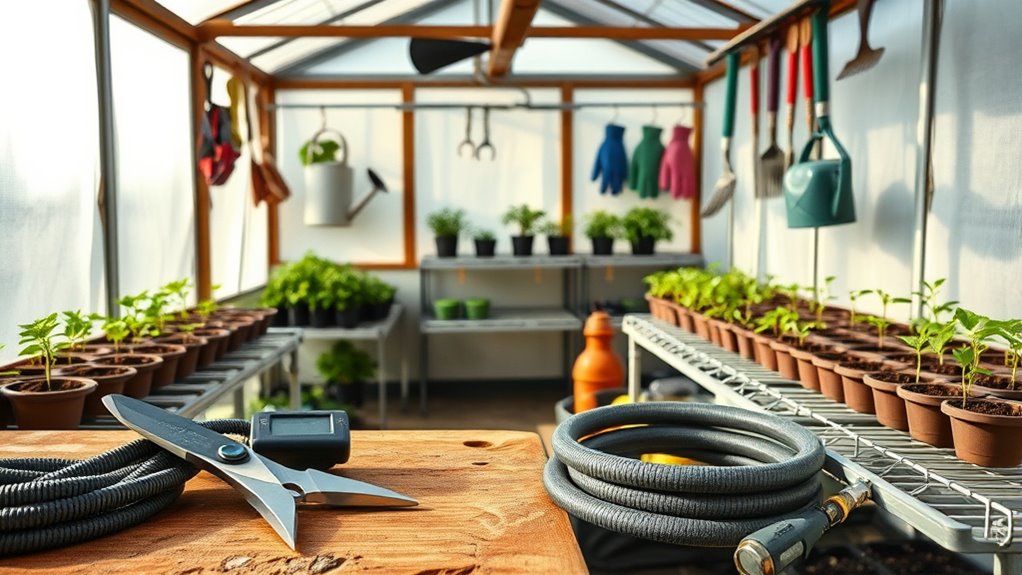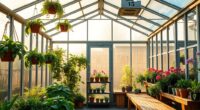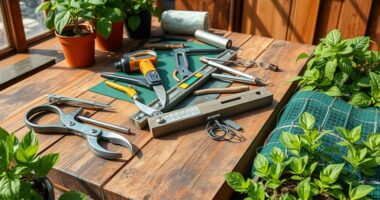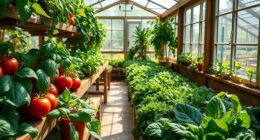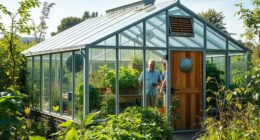To set up your greenhouse, start with essential hand tools like pruning shears and seedling trays to keep plants healthy. Equip yourself with soil testing kits and mixing tools to optimize soil conditions. Install irrigation systems and climate control devices, such as heaters, fans, and grow lights, to maintain ideal environment. Add sturdy shelves and pest management tools for organization and health. If you explore further, you’ll discover how each tool guarantees a thriving greenhouse.
Key Takeaways
- Gather essential hand tools like pruning shears, seedling trays, and soil testing kits for planting and soil preparation.
- Use soil mixing and blending equipment to ensure nutrient-rich, well-aerated soil tailored to plant needs.
- Install climate control devices such as thermostats, humidifiers, and automated ventilation for optimal growing conditions.
- Set up appropriate lighting solutions, including energy-efficient LED grow lights with adjustable settings for different plant stages.
- Incorporate sturdy shelving, pest management tools, safety gear, and maintenance supplies to ensure organized, safe, and healthy greenhouse operation.
Essential Hand Tools for Greenhouse Gardening
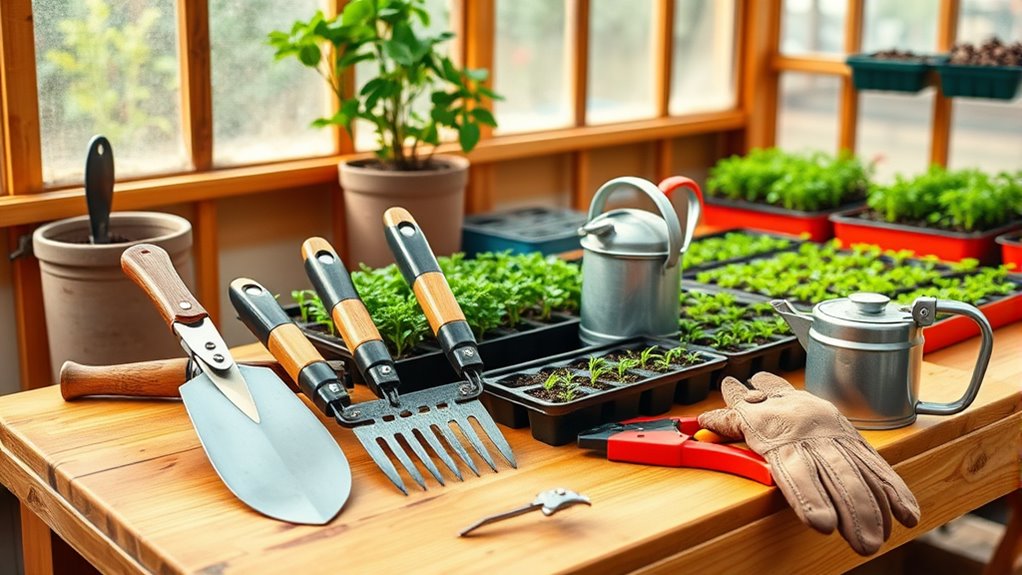
To get started with greenhouse gardening, you’ll need a few essential hand tools that make your work easier and more efficient. Pruning shears are crucial for trimming plants, removing dead or damaged leaves, and encouraging healthy growth. Choose sharp, comfortable tools to prevent plant damage and reduce hand fatigue.
Seedling trays are equally important, providing a controlled environment for young plants to develop strong roots before transplanting. They help organize your seedlings and protect them from pests and disease.
Keep your pruning shears clean and sharp for precise cuts, and use sturdy seedling trays to maximize space and growth potential. These tools form the foundation of effective greenhouse management, ensuring your plants thrive from the very start.
Soil Preparation and Mixing Equipment
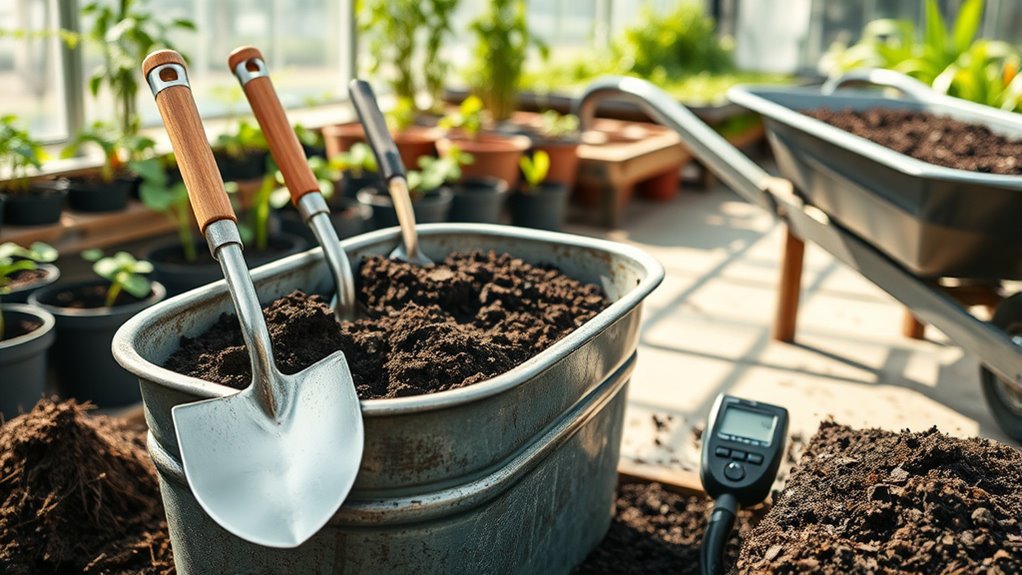
Before mixing your soil, you need to understand its current condition, so soil testing methods are essential. Once you know what adjustments are needed, choosing the right mixing and blending tools will make the process efficient. Proper equipment guarantees your soil is well-prepared for healthy plant growth in your greenhouse. Additionally, incorporating the right exfoliating agents can improve soil aeration and nutrient absorption, promoting healthier plant roots. Utilizing industry trends can also help you select innovative tools that enhance soil quality and planting success. Staying informed about vetted products and techniques ensures you use reliable and effective equipment for optimal results.
Soil Testing Methods
How do you guarantee your soil is properly prepared for planting? Soil testing methods are essential. First, perform soil nutrient analysis to determine which nutrients are deficient or excessive. Regular testing can prevent nutrient imbalances that hinder plant growth. Next, use a reliable soil test kit for nutrient analysis, and consider soil testing as part of your routine maintenance to monitor changes over time. Applying pH testing strips or electronic meters for pH levels, and interpret results to decide on amendments like fertilizers or lime. These tests help you customize your soil preparation, promoting healthy growth. Incorporating soil health practices can further enhance your soil’s vitality and productivity. Additionally, understanding soil structure can help you improve drainage and aeration, leading to better plant root development.
Mixing and Blending Tools
Mixing and blending tools are indispensable for creating uniform, well-prepared soil in your greenhouse. Plant nutrient mixers help you evenly distribute fertilizers and amendments throughout the soil, ensuring your plants receive consistent nourishment. Use these mixers to blend compost, soil, and nutrients thoroughly, preventing hotspots or deficiencies. Incorporating artistic elements into your planters can also enhance the visual appeal of your greenhouse setup. Liquid fertilizer dispensers are also crucial; they allow you to accurately apply liquid nutrients, saving time and reducing waste. Combining these tools helps you achieve a balanced, nutrient-rich medium tailored to your plants’ needs. Proper mixing ensures better aeration, drainage, and nutrient availability, promoting healthy growth. Regularly using watering tools ensures your soil remains properly moist and aerated, which is vital for root health. Maintaining soil homogeneity through consistent mixing helps prevent uneven plant growth and disease. Utilizing portable tools can also make soil preparation more efficient and flexible. Keep your soil homogeneous by using these tools regularly, and you’ll set a strong foundation for a productive greenhouse.
Irrigation Systems and Watering Tools
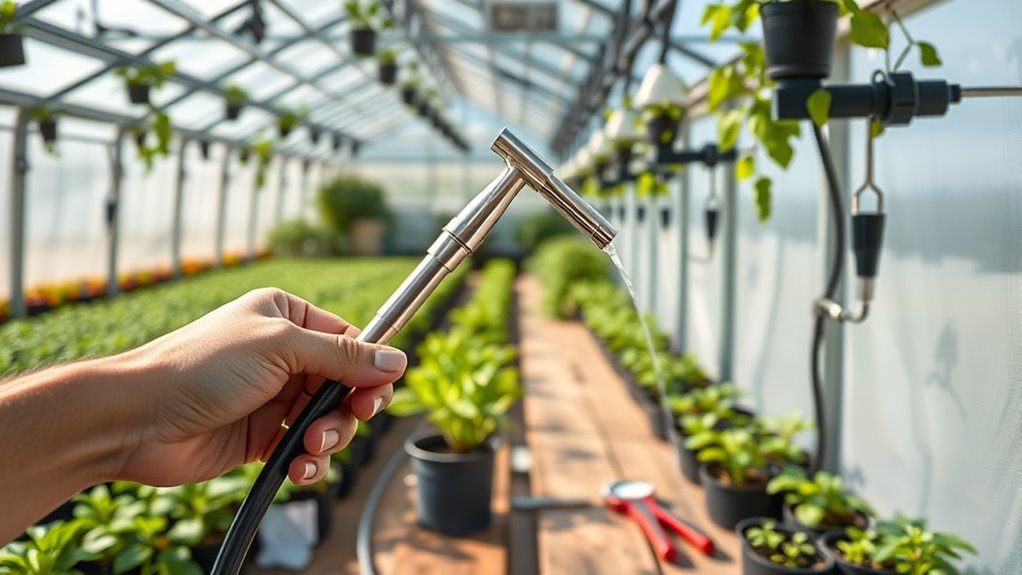
Choosing the right watering tools can make a big difference in your greenhouse. Drip irrigation offers efficient water delivery and reduces waste, while handwatering gives you control over individual plants. Understanding these options helps you maintain healthy, thriving plants with less effort. Additionally, incorporating water-saving techniques that suit your specific plant needs can further optimize growth and water conservation. Employing proper watering schedules ensures plants receive consistent moisture, preventing over- or under-watering issues. Knowing the return policies of your suppliers can also ensure smooth exchanges if you need to switch or upgrade your watering equipment. To effectively manage watering practices, it’s important to recognize the signs of spoilage in your water sources or supplies to prevent plant health issues.
Drip Irrigation Benefits
Have you considered how drip irrigation can transform your greenhouse watering routine? This system delivers water directly to plant roots, reducing waste and promoting healthy growth.
With drip irrigation, you benefit from:
- Precise watering that prevents over- or under-watering
- Significant water conservation by minimizing runoff and evaporation
- Reduced labor since it automates the watering process
- Healthier plants due to consistent moisture levels
- Incorporating automation technologies can further optimize watering schedules and improve overall efficiency. Additionally, selecting appropriate equipment ensures the system functions effectively and lasts longer. Proper maintenance of irrigation components is also essential to prevent clogs and leaks, ensuring the longevity of your system. Implementing space-saving solutions can also help in efficiently managing your greenhouse layout to accommodate the irrigation setup.
Handwatering Essentials
Ever wondered how to keep your greenhouse plants evenly watered without complex systems? Handwatering is simple and effective with the right tools. Watering cans are perfect for targeted watering, while spray bottles help with delicate seedlings and foliage. Visualize your watering tools like this:
| Tool | Use | Ideal for |
|---|---|---|
| Watering cans | Pouring water evenly over plants | Larger pots, hanging baskets |
| Spray bottles | Gentle misting for seedlings | Young plants, leaves |
| Handheld sprayers | Precise watering in tight spaces | Root zones, dense plantings |
| Reusable bottles | Portable watering on the go | Spot watering, maintenance |
With these essentials, you’ll maintain healthy, hydrated plants effortlessly.
Temperature and Humidity Control Devices
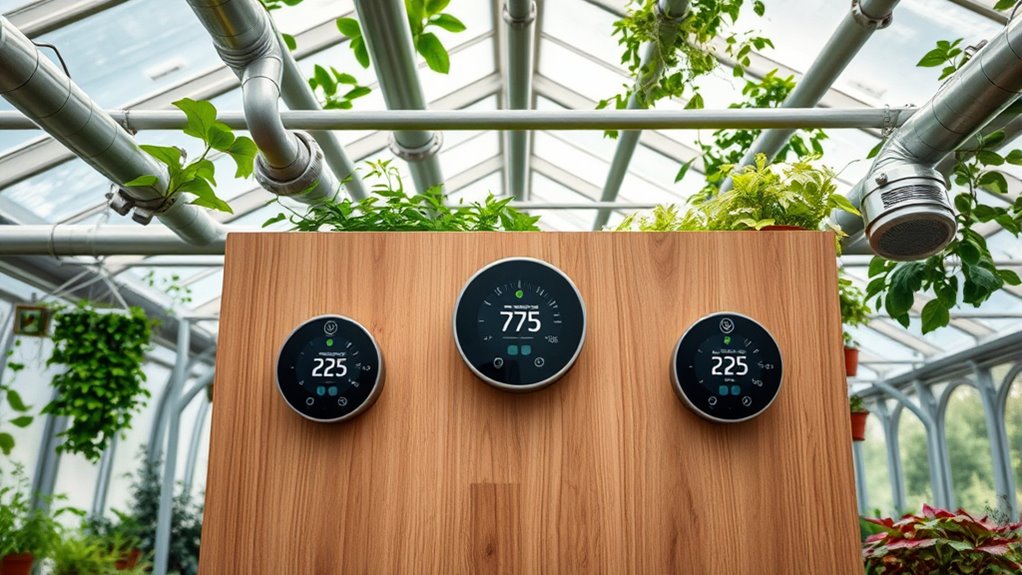
Maintaining the right temperature and humidity levels is crucial for a healthy greenhouse environment, and this is achieved through various control devices. Properly calibrated thermostats ensure accurate temperature regulation, so regularly check thermostat calibration to avoid fluctuations.
Humidity sensors track moisture levels, helping you maintain ideal conditions for your plants. Here are key devices to contemplate:
- Digital thermostats with precise temperature control
- Humidity sensors for real-time moisture monitoring
- Automated ventilation systems to regulate airflow
- Dehumidifiers and humidifiers for fine-tuning humidity levels
Using these tools, you can create a stable environment, prevent plant stress, and improve growth rates. Accurate control devices are essential for maintaining consistent conditions that support healthy greenhouse plants.
Lighting Solutions for Greenhouse Plants

Lighting is a crucial factor in optimizing plant growth inside a greenhouse, especially since natural sunlight can vary throughout the day and seasons. To guarantee consistent light, consider using LED grow lights, which are energy-efficient and customizable.
These lights can be adjusted to provide the ideal grow light spectrum, matching the specific needs of your plants at different stages. Full-spectrum LED grow lights mimic natural sunlight, promoting healthy photosynthesis and robust growth.
Shelving, Benches, and Plant Stands
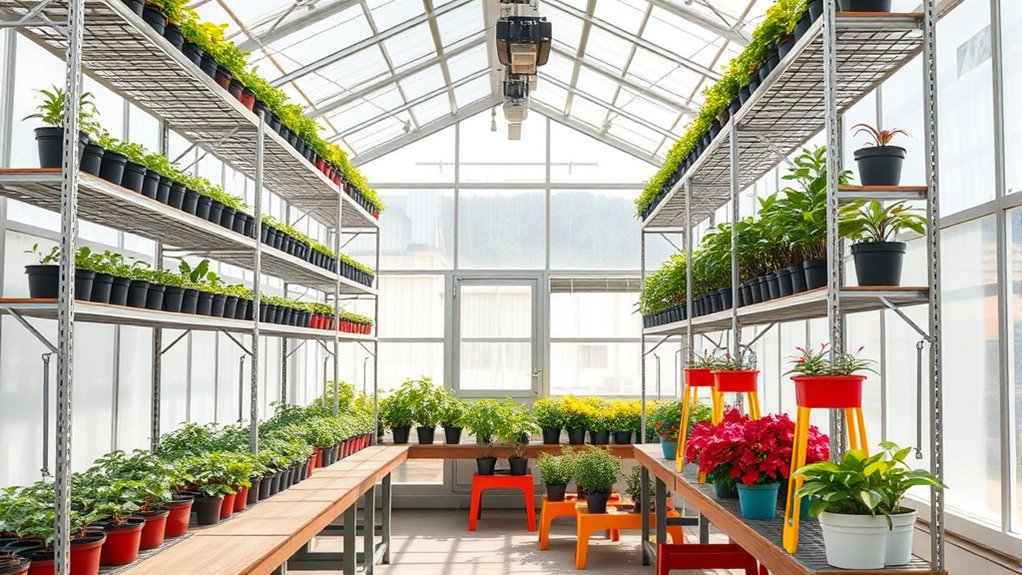
Choosing the right shelving, benches, and plant stands is essential for maximizing space and ensuring easy access to your plants. Proper shelving organization helps you efficiently utilize vertical space, making watering and maintenance easier.
Maximize space and access with proper shelving and plant stands for easy maintenance.
When selecting plant display stands, consider durability and height to showcase your plants effectively. Here are four key points:
- Use adjustable shelving to accommodate different plant sizes.
- Incorporate sturdy benches for heavier pots.
- Opt for plant display stands that improve visibility.
- Prioritize materials that resist humidity and corrosion.
Pest and Disease Management Tools

Ever wondered how to effectively keep pests and diseases at bay in your greenhouse? Using integrated pest traps is a smart move. These traps help monitor and reduce pest populations without chemicals, giving you early detection and control.
Combine this with disease-resistant plant varieties to minimize the risk of infections spreading. Selecting healthy, resilient plants from the start can save you time and effort later on.
Regularly inspecting plants and maintaining cleanliness also support your efforts. Proper placement of pest traps ensures you catch issues early, while choosing resistant varieties reduces the need for chemical interventions.
Together, these tools create a sustainable approach to pest and disease management, helping your greenhouse stay healthy and productive with less hassle.
Safety Gear and Maintenance Supplies
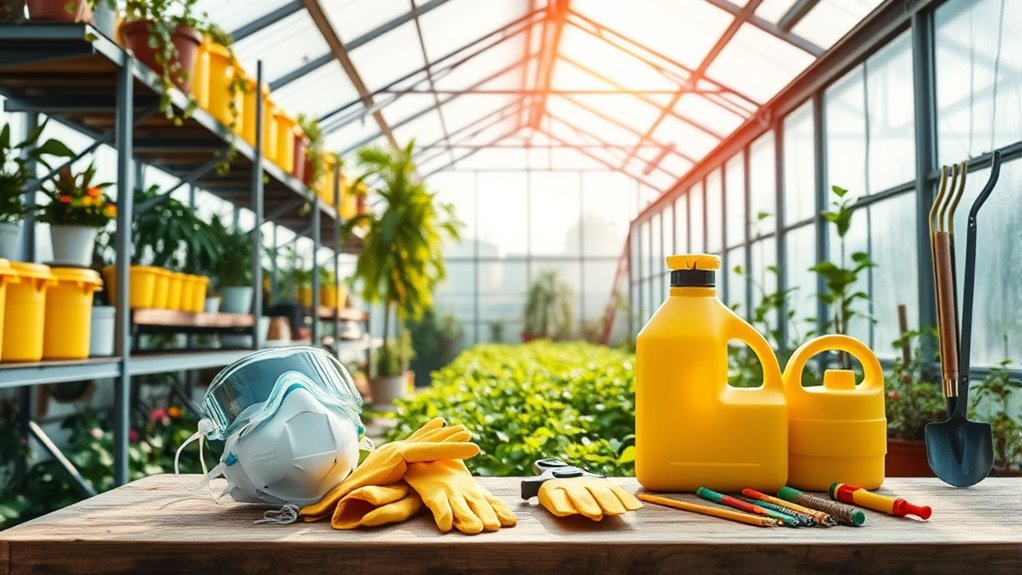
Maintaining a safe and efficient greenhouse environment requires more than just pest control and disease management. It also depends on proper safety gear and maintenance supplies.
First, always wear protective gloves to prevent cuts, chemical exposure, or infections.
Second, keep fire extinguishers accessible and regularly checked to handle any fire emergencies promptly.
Third, stock up on essential maintenance supplies like cleaning agents, spare parts, and lubricants to keep equipment in top shape.
Fourth, ensure safety signs are visible and up-to-date, reminding everyone of hazards and safety protocols.
These measures create a secure workspace, reduce risks, and promote smooth operations. Prioritizing safety gear and maintenance supplies protects both your plants and your team.
Frequently Asked Questions
How Do I Choose the Right Size Greenhouse for My Needs?
When choosing the right size greenhouse, think about your gardening goals and space. Consider ventilation strategies to guarantee proper airflow, which helps with pest management and plant health.
Smaller greenhouses are great for beginners or limited spaces, while larger ones suit extensive gardening projects.
Measure your available area, plan for future expansion, and prioritize functionality. This way, you create an efficient environment that supports healthy plants and easy maintenance.
What Are the Best Materials for Greenhouse Framing?
When choosing greenhouse framing materials, consider durability and climate.
Metal framing offers strength, longevity, and resistance to pests, making it ideal for long-term use.
Wooden structures provide natural insulation and aesthetic appeal, perfect for smaller or decorative greenhouses.
You’ll want to weigh these options based on your budget, maintenance preferences, and local weather conditions to select the best materials for your greenhouse’s framing.
How Often Should I Calibrate My Irrigation System?
You should calibrate your irrigation system regularly to guarantee ideal water delivery. Typically, you need to check sensor maintenance and adjust calibration frequency every few months, especially during seasonal changes.
Keep an eye on sensor readings and system performance; if you notice irregular watering, it’s time to recalibrate.
Consistent calibration helps prevent overwatering or underwatering, maintaining healthy plants and efficient water use.
What Are Eco-Friendly Options for Greenhouse Lighting?
For eco-friendly greenhouse lighting, you can choose solar-powered lights, which harness sunlight and reduce energy use.
LED grow lights are also an excellent option—they’re energy-efficient, have a long lifespan, and produce minimal heat, helping you save on cooling costs.
Combining solar-powered lights with LED grow lights provides sustainable, cost-effective illumination that supports your plants while minimizing your environmental impact.
How Can I Automate Climate Control for Optimal Plant Growth?
Getting your climate just right can feel like finding a needle in a haystack, but automation makes it easier. You should install automated ventilation systems and use climate sensors to monitor temperature, humidity, and light.
These tools work together to adjust airflow and other environmental factors automatically, ensuring ideal conditions for your plants.
With automation, you’re not flying blind—you’re in the driver’s seat for a healthy, thriving greenhouse.
Conclusion
With these tools in hand, your greenhouse becomes a thriving oasis, a lush sanctuary bursting with life. Think of your equipment as the brushstrokes on a vibrant canvas, each piece working in harmony to nurture growth. As you tend to your plants, you’ll watch your green haven flourish, like a symphony of colors and scents. Embrace these essentials, and you’ll cultivate not just plants, but a slice of paradise right in your own backyard.
